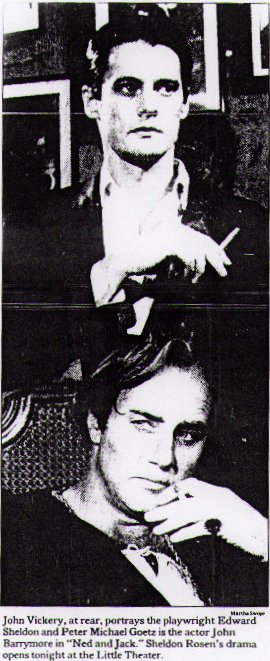
Although Miss Kauser urged Sheldon to refrain from submitting that play to producers - she felt it too closely resembled a current Broadway hit - she encouraged him to write another. The result was ''Salvation Nell,'' the story of a down-and-out woman who remains loyal to her imprisoned lover and finds happiness in dedication to God.
Inspired by observations Sheldon made while attending Salvation Army meetings, the play reflected the views of a wealthy outsider looking in on the lives of the less fortunate, but in 1908 the notion of even depicting characters from the seamy side of society was mildly outrageous. Indeed at a time when classics, on one hand, and genteel drawing room comedies, on the other, were the order of the day, ''Salvation Nell'' represented a major step toward melodramatic realism in the theater. ''Ned put guts on the American stage,'' said Mr. Rosen. ''His plays were awfully romantic, but he showed the problems of everyday people, and they were people in genuine conflict - not worrying about what they should wear to the ball, but what they should do with their lives.''
Much acclaimed at the time, Sheldon's plays now seem, as Brooks Atkinson once wrote, ''maudlin, sentimental, melodramatic'' - the first act of ''Salvation Nell'' ended with Christmas carols; the second with the Lord's Prayer - but they were infused with the playwright's sure theater sense and provided actresses with dependably dramatic roles. What's more, Sheldon's craftsmanship raised the melodrama of the day to a new level, and in doing so provided later generations of playwrights with intimations of the theater's possibilities. Clever and technically dexterous, Sheldon's plays were perhaps superior entertainment, but they remained entertainment nonetheless; it would be left to his successors - Eugene O'Neill, who would effectively transform the American theater, and later Tennessee Williams, Arthur Miller and others - to raise the level to an art form.
Some 17 years after the opening of ''Salvation Nell,'' Eugene O'Neill wrote Sheldon a letter, in which he acknowledged his debt. ''Your 'Salvation Nell,' '' he wrote, ''along with the work of the Irish Players on their first trip over here, was what first opened my eyes to the existence of a real theater as opposed to the unreal - and to me, then hateful - theater of my father, in whose atmosphere I had been brought up ...My inner conviction has always been that you are one of the rare ones who really understand and have a right to speak, and to be listened to, whether of praise or blame.''
The season it opened, ''Salvation Nell'' was acclaimed, in the words of one critic, as ''the most daring play New York has ever seen,'' and its young author quickly became the toast of Broadway. He was invited to the most glittering of parties, and his name was mentioned in the columns. He also continued to write, frequently working on several plays at a time.
The story of a Southern politician who discovers that he is partly black, ''The Nigger,'' produced in 1909, proved as provocative as its title. Sheldon's next play, ''The Boss,'' which concerned the maneuverings of a big-city political boss, was also timely, based, in part, on the muckraking exposes of Lincoln Steffens and Ida Tarbell. Although both plays were couched in romantic terms - each focused on the relationship between the protagonist and a woman - they also addressed important social issues, something few Broadway plays had ever assayed before.